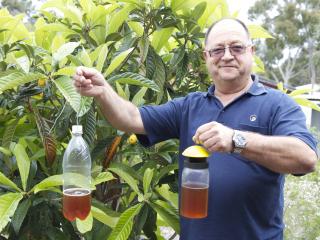Lure and kill traps
Lure and kill devices work in a similar way to baits, exploiting the need for female Medflies to obtain dietary protein for egg production. Traps are hung on trees and the protein in the trap attracts male and female flies. Depending on the design, the flies drown or obtain a lethal dose of insecticide.
Nurseries sell a lure and kill device which consists of a plastic container containing a liquid that is attractive to Medflies. The flies enter through small holes in the lid, and eventually drown in the liquid. Freshly-killed flies float on the surface.
You can also make your own traps out of empty soft drink or water bottles, or 2 litre milk or juice cartons. Remove the label first as it may deter flies or attract young children. Drill, punch or burn at least four holes on opposite sides of the bottle, near the ‘shoulders’. The size of the holes should be 6-8mm. The trap can be hung from its neck by wire or string to a branch. Fill one-third of the trap with your recipe.
Many fruit fly trap recipes are available on the web or use the suggestions below.
Homemade or commercial devices should be hung 1.5-2m above the ground in fruit trees. These do not need to be fruiting at the time. Try to place the device in the shady part of the tree. Some traps can also be placed in nearby non-fruiting trees where flies may shelter.
The attractiveness of food lures extends just a few metres, so traps should ideally be no more than 5–6m apart. You should hang at least two homemade traps per tree.
Traps may dry out during summer and should be topped up with more liquid. The entire contents of homemade traps should be replaced at least weekly, as the trap contents will attract other insects besides medfly. However, a commercial lure is likely to attract medfly only. If a trap dries out, medflies may still be attracted, but will not be killed. When disposing of the trap contents, make sure that you do so away from fruit trees as the liquid may attract medflies.
Lure and kill devices are not likely to kill all flies present, as the ripening fruit may be more attractive to the female medfly than the trap contents.
Lure and kill devices can be used in conjunction with baiting or physical exclusion, which could involve fly-proof bags tied around individual fruits or branches.
Recipes to add to traps
Solution 1
80 grams white sugar
1.5g dry brewer's yeast
920mL water
Solution 2
5mL imitation vanilla essence
20mL household ammonia
1L water
Solution 3
Peel from 6 mandarins or two oranges
50mL household ammonia
1L water
Solution 4
1 teaspoon borax
1tsp sugar
2tsp bran
1L water
Physical exclusion
Whole trees or fruits can be protected by excluding Medfly with mosquito netting, shade-cloth or nylon flyscreen. Large nets will need to be supported by a frame. Frames for nets to enclose whole trees can be made from polyethylene irrigation pipe (5cm in diameter), which does not lose its shape in the sun. The frame is constructed by crossing over and tying together two lengths of pipe over the tree.
Frames can be secured in the ground by slipping the end of poly-pipe over posts such as star pickets embedded in the ground. Covers should only be left in place while fruit is ripening to avoid damage to the tree.
Individual fruits or branches can be protected by making bags or sleeves out of cloth such as gauze curtain material, muslin or mosquito netting. Tie-off bags around the base of the fruit or branch with a twist tie or string. Commercial fruit fly exclusion bags are also available in either waxed paper or cloth.
Final advice
There is no 'silver bullet' to rid fruit trees in home gardens of Medfly which is widespread throughout south-west Western Australia. If all property owners in a neighbourhood work together to control the pest, there is a much better chance of keeping populations down so that everybody can enjoy harvesting unblemished fruit.
The Department of Agriculture and Food, Western Australia (DAFWA) needs your help to detect animal and plant pests, diseases and weeds that could pose a threat to agricultural industries.
Contact
Commercial and industry enquiries should be directed to Medfly Compliance; all public enquiries should be directed to PaDIS.

